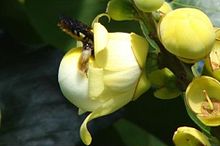
A pollinator is an animal that moves pollen from the male anther of a flower to the female stigma of a flower. This helps to bring about fertilization of the ovules in the flower by the male gametes from the pollen grains.

A bumblebee is any of over 250 species in the genus Bombus, part of Apidae, one of the bee families. This genus is the only extant group in the tribe Bombini, though a few extinct related genera are known from fossils. They are found primarily in higher altitudes or latitudes in the Northern Hemisphere, although they are also found in South America, where a few lowland tropical species have been identified. European bumblebees have also been introduced to New Zealand and Tasmania. Female bumblebees can sting repeatedly, but generally ignore humans and other animals.
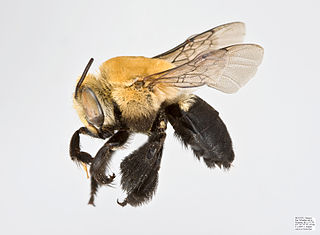
The genus Centris contains circa 250 species of large apid bees occurring in the Neotropical and Nearctic realms, from Kansas to Argentina. Most females of these bees possess adaptations for carrying floral oils rather than pollen or nectar. They visit mainly plants of the family Malpighiaceae to collect oil, but also Plantaginaceae, Calceolariaceae, Krameriaceae and others. Recent studies have shown they are sister to the corbiculate bees, the most well-known and economically important group of bees
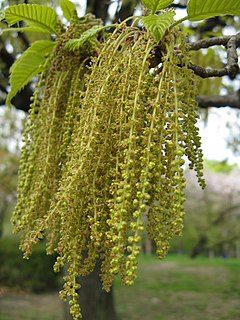
Anemophily or wind pollination is a form of pollination whereby pollen is distributed by wind. Almost all gymnosperms are anemophilous, as are many plants in the order Poales, including grasses, sedges, and rushes. Other common anemophilous plants are oaks, pecans, pistachios, sweet chestnuts, alders and members of the family Juglandaceae. Approximately 12% of plants across the globe are benefited by anemophily, including cereal crops like rice and corn and other prominent crop plants like wheat, rye, barley, and oats. In addition, many pines, spruces, and firs are wind-pollinated, and people rely on these hardwood trees for their survival.

The tribe Euglossini, in the subfamily Apinae, commonly known as orchid bees or euglossine bees, are the only group of corbiculate bees whose non-parasitic members do not all possess eusocial behavior.

A flower, sometimes known as a bloom or blossom, is the reproductive structure found in flowering plants. The biological function of a flower is to facilitate reproduction, usually by providing a mechanism for the union of sperm with eggs. Flowers may facilitate outcrossing resulting from cross pollination or allow selfing when self pollination occurs.

A scopa is any of a number of different modifications on the body of a non-parasitic bee that form a pollen-carrying apparatus. In most bees, the scopa is simply a particularly dense mass of elongated, often branched, hairs on the hind leg. When present on the hind legs, the modified hairs are, at a minimum, on the tibia, but some bees also have modified hairs on the femur and/or trochanter. A few bees have, in addition to the leg hairs, many modified hairs on the ventral surface of the abdomen which are also used in pollen transport; there is one family of bees, Megachilidae, in which the modified leg hairs are absent, and the scopa is limited to the abdominal hairs. In the familiar honey bees and bumblebees, the scopa is replaced by the pollen basket (corbicula). Bees have other types of modified hairs used to collect pollen, floral oils, or other chemicals from plants, and these can be on the face, mouthparts, or the front or middle legs, but these are not scopae; the term is explicitly restricted to hairs used to transport pollen. There are some bees which transport pollen internally in the crop, and these lack a scopa, as do cleptoparasitic bees, which do not gather their own pollen.

The Apinae are the subfamily that includes the majority of bees in the family Apidae. It includes the familiar "corbiculate" bees—bumblebees, honey bees, orchid bees, stingless bees, and the extinct genus Euglossopteryx. It also includes all but two of the groups that were previously classified in the family Anthophoridae.

The bee tribe Ctenoplectrini of the subfamily Apinae, with the two genera Ctenoplectra and Ctenoplectrina, comprises 9 species in tropical Africa, 10 in Asia, and 1 in Australia.
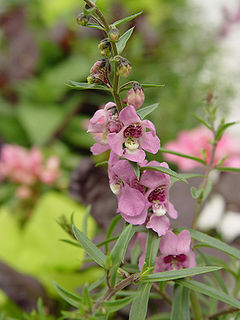
Angelonia is a genus of about 30 species which occur from Mexico to Argentina and is classified in the Plantaginaceae. They are herbaceous plants occurring mainly in arid and semi-arid habitats. Most Angelonia species can be found in Northeastern Brazil in the Seasonally Dry Tropical Forest namely Caatinga. The flowers of Angelonia are highly specialized for pollination because they have hairs in the inner corolla, which produces oils collected by oil bee pollinators, especially of the genus Centris.

The Centridini are a tribe of large apid bees, many of which possess adaptations for carrying floral oils rather than pollen or nectar. The floral oils are often gathered from plants of the family Malpighiaceae, though other plants may be visited. The oil-collecting species typically have "combs" composed of closely spaced, flattened, blunt bristles on the margins of the first tarsal segments of the front and middle legs; others may have velvety "pads" to absorb the oils. They also commonly gather plant resins for use in nest cell construction. They have a tiny pterostigma in the forewing, the female scopa is very bushy, and the first flagellomere of the antenna is often longer than the scape.

Pollination syndromes are suites of flower traits that have evolved in response to natural selection imposed by different pollen vectors, which can be abiotic or biotic, such as birds, bees, flies, and so forth. These trait includes flower shape, size, colour, odour, reward type and amount, nectar composition, timing of flowering, etc. For example, tubular red flowers with copious nectar often attract birds; foul smelling flowers attract carrion flies or beetles, etc.

The genus Tetrapedia contains approximately 13 species of small apid bees occurring in the Neotropics, and they are unusual in possessing adaptations for carrying floral oils rather than pollen or nectar. The floral oils are typically gathered from plants of the family Malpighiaceae, though other plants may be visited. They also apparently gather plant resins for use in nest cell construction, sometimes mixed with sand.

Propolis or bee glue is a resinous mixture that honey bees produce by mixing saliva and beeswax with exudate gathered from tree buds, sap flows, or other botanical sources. It is used as a sealant for unwanted open spaces in the hive. Propolis is used for small gaps, while larger spaces are usually filled with beeswax. Its color varies depending on its botanical source, with dark brown as the most common. Propolis is sticky at and above 20 °C (68 °F), while at lower temperatures it becomes hard and brittle.
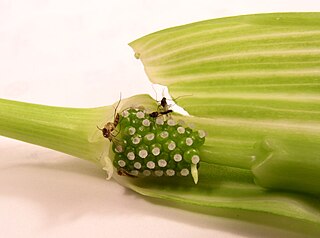
Pollination traps or trap-flowers are plant flower structures that aid the trapping of insects, mainly flies, so as to enhance their effectiveness in pollination. The structures of pollination traps can include deep tubular corollas with downward pointing hairs, slippery surfaces, adhesive liquid, attractants, flower closing and other mechanisms.

Eufriesea surinamensis belongs to the tribe of euglossine bees and as such is a species of orchid bee. This should not be mistaken with the species group surinamensis, which includes Ef. surinamensis among other Eufriesea species.

Paratrigona subnuda, commonly known as the jataí-da-terra, is a species of eusocial stingless bee in the family Apidae and tribe Meliponini. These social bees are prevalent in Neotropical moist forests, including Brazilian Atlantic and other South American forests. They inhabit spherical nests in moist underground environments with their forest habitats. Within their Neotropical habitats the P. subnuda is considered to be a very successful and common species of bee. P. subnuda’s main source of food is pollen and nectar from a large variety of native Mesoamerican tropical plants. They have been extensively studied due to social conflicts arising from single mate behaviors and particular virgin behaviors. P. subnuda also exhibits the particular daily behavior in which they open the nest entrance at dawn and close the entrance at dusk when all their activities are done.

Macropis nuda is a ground nesting, univoltine bee native to northern parts of North America. Thus, this species cocoons as pupae and hibernates over the winter. The species is unique as it is an oligolectic bee, foraging mainly for floral oils from Primulaceae of the genus Lysimachia.
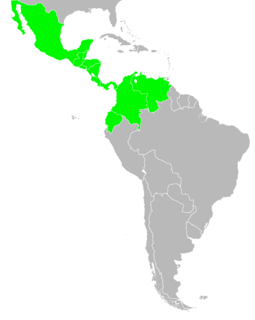
Trigona fuscipennis is a stingless bee species that originates in Mexico but is also found in Central and South America. They are an advanced eusocial group of bees and play a key role as pollinators in wet rainforests. The species has many common names, including "mapaitero", "sanharó", "abelha-brava", "xnuk", "k'uris-kab", "enreda", "corta-cabelo", "currunchos", "zagaño", and "enredapelos".
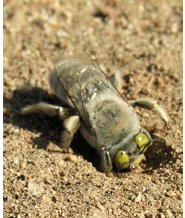
Centris pallida is a species of solitary bee native to North America. It lacks an accepted common name; however, it has been called the digger bee, the desert bee, and the pallid bee due to its actions, habitat, and color respectively. The solitary nature of this bee allows for a dual-strategy mating system which produces an evolutionarily stable state resistant to invading strategies. These bees have also evolved to withstand the high temperatures of their native habitat. C. pallida routinely has internal temperatures within 3 degrees Celsius of death.
